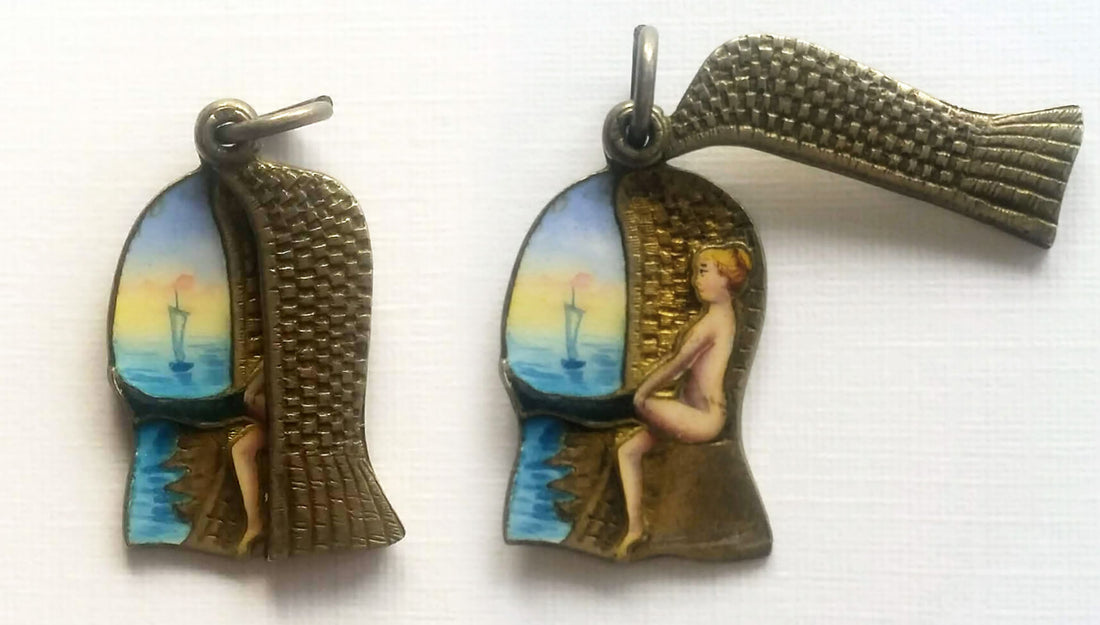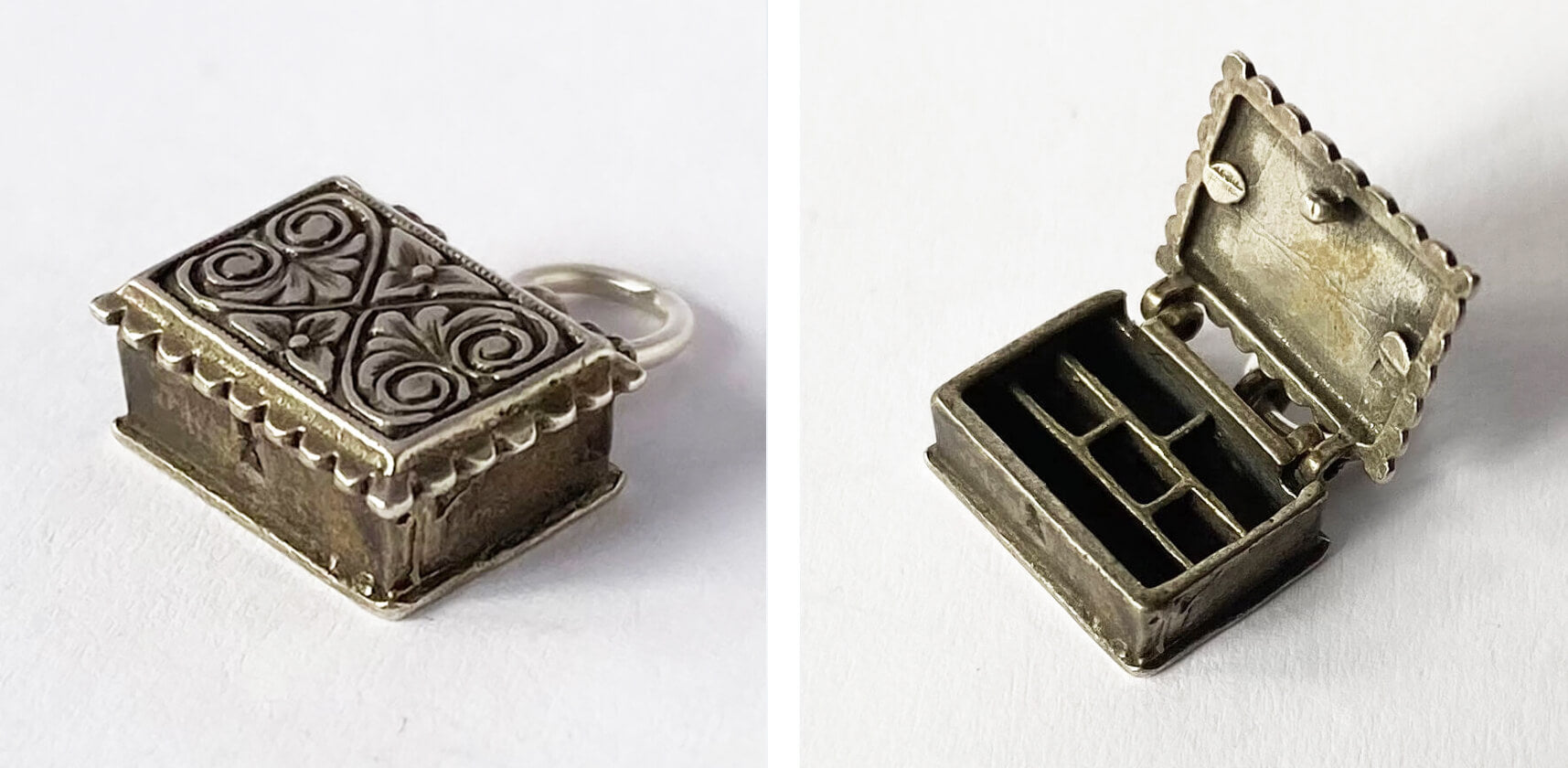
Open Sesame! The Secret World of Mechanical Charms
Share
Unlocking the Secrets of Moving, Mechanical, and Opening Charms: A Journey Through History and Craftsmanship
The world of jewellery has long been enchanted with these miniature wonders—intricately crafted pieces that do more than dangle. Among the most beguiling are moving and opening charms. These tiny trinkets not only catch the eye; they stir the imagination, tell stories, and often conceal delightful surprises. Today, we explore their history, craftsmanship, symbolic meanings, and the many designs that have captivated collectors for generations.

A Brief History of Charms
The tradition of wearing charms dates back millennia. In Ancient Egypt, charms were used as amulets, believed to provide protection, ward off evil, or ensure safe passage to the afterlife. Later, during the Roman Empire, Christians concealed tiny fish-shaped charms to signal their faith covertly. The use of charms shifted from spiritual to decorative over time, particularly flourishing during the Victorian era.
It was Queen Victoria herself who helped popularise charm bracelets in the 19th century. Her collection included miniature lockets, portraits, and mementoes of family, sparking a fashion trend among the aristocracy and eventually the broader public. Many of these charms were not merely ornamental—they moved, opened, or housed hidden messages or photographs, setting the stage for the charm as a mechanical marvel.

The Allure of Movement
Moving charms are designed with components that shift, swing, or rotate. These dynamic elements add a kinetic magic to the piece, transforming it from a static adornment into an engaging object of fascination. Common designs include vehicles with turning wheels, windmills with spinning sails, and animals with wagging tails or flapping wings.
The Victorian and Edwardian eras saw the rise of “spinner” charms—discs or motifs mounted on pivots, which rotated to reveal different sides. Sometimes these featured contrasting inscriptions, such as “yes” and “no,” or bore illustrations that changed depending on the angle. These were not only entertaining but often carried symbolic meaning or served as discreet decision-making tools.
In more recent times, designers have incorporated articulated limbs in figures—dancers that kick, jesters that tumble, and birds that peck—all springing to life with the flick of a wrist. The movement often mirrors the theme, imbuing the charm with personality and playfulness.

Mechanical Wonders: Ingenious Miniature Engineering
Mechanical charms take movement to another level by incorporating working mechanisms. These might include gears, hinges, pulleys, and clasps that mimic full-sized contraptions in miniature. Some of the most admired pieces replicate everyday items: a typewriter with moving carriage, an egg which opens to a chick, or a sewing machine with a turning wheel.
European jewellers in the early 20th century gained acclaim for their mechanical charms, many of which were marvels of precision. From enamelled opening fan charms to rotating daisy charms, there seemed to be no limit to designers’ imaginations.
These charms were often designed to celebrate technological advancement—tiny tributes to the age of invention. They weren’t just decorative; they embodied the spirit of innovation, making them popular gifts for milestones such as graduations, retirements, or anniversaries.

Opening Charms: Hidden Depths
Opening charms are among the most intimate of their kind. Crafted with hinges, lids, or secret compartments, they invite curiosity and interaction. The most common form is the locket, a classic design that dates back to the Renaissance. Traditionally used to hold a lock of hair, a miniature portrait, or a tiny scroll, lockets are emotionally resonant—keepsakes of love, remembrance, and hope.
Victorian mourning jewellery often featured opening compartments holding hair from a deceased loved one. These were worn as private symbols of grief and devotion. Hidden mechanisms kept the contents secure and sometimes concealed from view, in keeping with the era’s strict codes of decorum.
Opening charms come in myriad forms beyond the traditional locket. Miniature books with turning pages, treasure chests with hinged lids, or globe charms that open to reveal tiny maps or religious scenes are just a few examples. The element of discovery is key—each charm offers a narrative moment, a theatre in miniature.
Some are deliberately humorous or whimsical. A charm shaped like a toilet may open to reveal a humorous word or two, while a perfectly innocent-looking house may conceal an amorous couple. These double-entendres and unexpected delights are part of the charm’s enduring appeal.

Folklore and Symbolism
Many mechanical and opening charms draw from folk tales, legends, or superstition. A charm that opens to reveal a four-leaf clover or a horseshoe invokes good luck, echoing ancient talismans. A treasure chest might symbolise hope or hidden potential, while an opening book charm might represent wisdom or a love of learning.
Charms shaped like hearts that split in two were often exchanged between lovers or friends, a tradition that continues to this day. When worn together, they signify union; apart, they represent longing or connection across distance. These personal meanings make such charms heirlooms to be passed down through generations.

Idioms and Language of Charms
The enduring presence of charms in language reflects their cultural importance. Phrases such as “charmed life,” “lucky charm,” or “third time’s the charm” point to their role as symbolic protectors or bearers of fate. “Working like a charm” alludes to the effective, almost magical functioning of a well-crafted item—very much in line with the mechanical ingenuity of these small masterpieces.
The word “charm” itself is rooted in the Latin carmen, meaning song or incantation, tying it back to ancient spells and oral traditions. Even today, to say something is “charming” suggests an enchantment beyond the visual—a draw that is emotional, tactile, even spiritual.
Probably the most delightful of all, is that the collective noun for a flock of goldfinch is a “charm of goldfinches”.

Designs Through the Ages: The Evolution of Enchanting Mechanics
The enduring appeal of moving and opening charms lies not only in their mechanical intrigue but in how their design sensibilities reflect the cultural and artistic trends of their time. Across the centuries, these miniature marvels have changed in form, function, and aesthetic—but always with the same aim: to surprise, delight, and tell a story.
Victorian Sentiment and Symbolism (1837–1901)
The Victorian era marked a golden age for symbolic jewellery, with Queen Victoria herself a notable influence on fashion and sentimentality. Opening lockets became especially popular, often designed in gold or rolled gold, with delicate floral engravings or chased patterns. Some heart-shaped charms split into two halves, designed to be shared by lovers or close friends.
Moving charms of this period were rarer, though some did exist—watch fob charms with swivelling seals were popular among gentlemen, and certain novelty pieces included animals with jointed limbs, like dogs with moving legs or birds with articulated wings.
Art Nouveau (1890–1910): Ornament Meets Nature
The Art Nouveau period ushered in sinuous, nature-inspired forms, often featuring flowing lines, florals, and fairytale imagery. Charms became more sculptural and expressive. Though not always mechanical in nature, some exquisite pieces incorporated motion to mimic the natural world.
An example from this era might be a dragonfly charm with wings that move, created through delicate articulation. Another would be a flower bud charm that opens to reveal a pearl, representing purity and hidden beauty.

Art Deco Geometry and Innovation (1920–1939)
The Art Deco period brought sharp lines, bold colours, and geometric designs. Technology and progress inspired many of the mechanical charms of this era, which often reflected contemporary inventions.
Among the most iconic were miniature working padlocks, many of which could actually open with a tiny key. These weren’t just symbolic; they were functional and often engraved with monograms or secret messages.
Another charming piece from the 1930s is the flipping picture frame charm—a tiny rectangular frame on a swivel that reveals different photographs or inscriptions when turned. These were often made in sterling silver or enamelled metal, combining function with deco-style minimalism.
Mid-Century Novelty and Mass Appeal (1940s–1960s)
Post-war optimism led to a boom in novelty jewellery, especially in Britain and America. The 1950s and ’60s were particularly prolific for fun, mechanical charms, often sold as collectables to be added to a charm bracelet over time. These pieces were joyful, cheeky, and sometimes downright bizarre—miniature stories in themselves.
Mid-century designs, particularly from the 1950s and ’60s, also embraced novelty and kitsch. These decades saw a boom in charm bracelet collecting, particularly in Britain and America. Manufacturers produced themed charms en masse—holidays, hobbies, and professions all found expression in mechanical form. One standout is a mechanical washing machine charm, which had a tiny door that opened to reveal enamelled laundry inside. Others included telephones with rotating dials, flowers that opened to insects, and suitcases that opened to show tiny clothes.
British brands like Nuvo and CHIM produced hundreds of intricate opening charms, including cottage charms that opened up to show a living room scene, or caravan charms that opened to reveal a furniture.

1960s–70s British Seaside Souvenirs
During the swinging ’60s and into the ’70s, souvenir charm bracelets became increasingly affordable and popular, particularly for young girls. Sold at seaside towns and tourist shops, these often kitsch pieces were playful, affordable, and designed for interaction.
Charming examples from this period are fortune tellers, articulated fish, moving chips and opening deck chairs. Others featured postboxes that opened to show love letters, or ice cream vans with opening windows and tiny ice cream cones inside.
Though less refined than their earlier counterparts, these pieces have become popular for their nostalgia and quirky appeal.
Modern Revival and Contemporary Craftsmanship (2000s–Today)
In recent decades, there’s been a renaissance in charm design, blending old-world techniques with contemporary storytelling and technology. Today’s designers often combine vintage aesthetics with contemporary themes. Some use recycled metals and 3D printing to create bespoke moving charms. Whether traditional or modern, the guiding principle remains the same: to surprise, delight, and tell a story.
High-end jewellers like Tiffany & Co. and Annoushka have introduced collections that feature subtle motion—like spinning globes, opening apples with hidden hearts, or suitcases with pull-out travel tags.
Artisans and independent jewellers are also reviving traditional mechanics with 21st-century twists. For instance, 3D-printed charms with functioning parts offer a new level of customisation.
More bespoke creators have returned to handmade, heirloom-quality opening charms, including lockets with hand-painted miniatures, or book charms with actual turnable pages inscribed with poems or quotes.
Collecting and Caring for Moving Charms
Because of their intricacy, mechanical charms require a gentle touch. Hinges and pivots should be checked regularly to prevent stiffness or breakage. Cleaning should be done with care, ideally by hand, to preserve delicate parts. For collectors, provenance can add significant value—charms by renowned makers such as Walter Lampl or Thomas L Mott, amongst others, are particularly sought after.
A well-curated charm bracelet becomes a wearable biography. Each piece can mark a chapter—travel, birth, loss, achievement. Collectors often speak of the tactile pleasure in handling the charms, turning wheels, opening lids, or watching them move. It’s jewellery that invites interaction and connection, unlike any other.

Conclusion
Moving, mechanical, and opening charms offer more than decoration—they are miniature theatres, storytelling devices, and feats of craftsmanship. Rooted in history yet ever evolving, these charms hold a mirror to our lives and imaginations. Their designs may change, but their appeal remains constant: they are treasures not just to be worn, but to be explored.
In a world increasingly driven by digital distraction, the intricate magic of a charm that moves, opens, or transforms reminds us of a simpler kind of wonder—the kind that fits in the palm of your hand.
